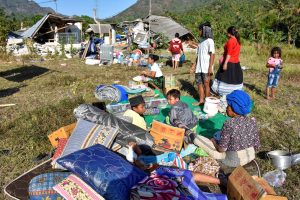
By Brian Thevenot
HOUSTON (Reuters) – Houston’s Nine-year old Melody Rodriguez saw a snake swimming toward her through the floodwaters. Reginald James Jones, Jr., also nine, had to climb into the attic to escape water up to the roof.
His sister, seven-year-old Ta’lilia Smithers had screamed that her family would die as the water rose quickly in their home.
These children and others who were rescued on Sunday and ferried on city dump trucks to Houston’s George R. Brown Convention Center also brought wonder and resilience to their perspective on the torrential rains from Hurricane Harvey that drowned their homes.
Their fascination after witnessing the power of nature escaped their beleaguered parents in the cavernous hall.
Being up in that attic was “fun,” Reginald said.
“It was a really big attic,” he said. “The attic kept us calm. I could see everything from up there – all the flooding. And I could see downtown.”
His little sister, 5-year-old Jakayla Taylor, marveled at how the “whole city was flooded – like a beach.”
Ta’lilia found took comfort in knowing she would probably get “a whole week off of school.”
“But momma says she can’t wait for us to go back to school, so she can have her eight hours of peace,” she added.
Late Sunday evening, Melody had recovered from the snake scare of that morning and reveled in the retelling. The people at the shelter, she said, were just so nice.
“They gave us pizza, lasagna, hot dogs, potato chips – and they also gave me these shoes,” she said, showing off her new purple rubber kicks. “Oh, and this hand sanitizer.”
Melody’s mother, who had five more children with her between the ages of 4 and 15, smiled as she watched her daughter excitedly tell flood stories and play with stuffed animals the Red Cross gave out.
As far as storm shelters go, this one was well-staffed and comfortable – a world away from the nightmarish scene at the ad hoc shelter at New Orleans’ convention center 12 years ago during Hurricane Katrina.
Houston’s experience with Harvey has drawn comparisons with the disaster that hit New Orleans, but there are many contrasts.
Nearly all of Houston’s downtown, for instance, appeared to have power Sunday night, along with many other areas of the city. Unlike New Orleans, Houston did not suffer a catastrophic wind storm before the flooding began, nor the massive levee failures that let in all the water at once.
Emergency management officials and the Red Cross had more time to organize shelters in Houston as Harvey first pounded coastal cities further south along the Texas coast, including Rockport.
Melody’s mom, 37-year-old Aeisha Brimzy, said her family’s every need had been handled since they arrived.
“It has been like all of us coming together,” she said of the flood victims at the convention center. “It’s been so peaceful. They have been feeding us all day, giving the kids snacks. The volunteers and the Red Cross and the police, they are really doing their job.”
Just then, a voice over the loudspeaker said: “If you need dry clothes, go to your cot. We are handing out fresh, dry clothes.”
A few yards away, people gathered around a big-screen TV taking in the latest storm news.
A volunteer came by to offer the kids more hot dogs. The youngsters said they were already full.
Earlier in the day, the children had suffered a harrowing trauma.
“Momma, is it going to get higher? I can’t swim,” Brimzy recalled one of her six-year-old twins, Carolina, saying as the water from Buffalo Bayou rushed into their apartment in Clayton Homes, a public housing development on the east side of downtown.
Melody showed a mix of sadness at some of her losses and bewilderment at what she had witnessed.
“My back pack is gone. I lost two tablets and some other very valuable stuff,” she said, referring to her Apple iPads. “And two pairs of name-brand shoes.”
“Our table, it was floating in the water! It was so high that our couch was floating around. But momma’s vases just sank,” Melody said.
Another daughter, 13-year Leeanta Rodriguez, had spent the night before tossing and turning in bed.
“I couldn’t sleep, because I knew that bayou was going to come up,” she said.
Sure enough it did, at about dawn. She carried her sister, Carolina, out of the flood and to the rescue trucks on her back.
Now at the shelter in the late evening, Leeanta worried about more practical things, like whether she would have to change schools, which she didn’t want to do. She said she loved her friends and her basketball team at Pershing Middle School.
Across the big room where they gathered, seven-year-old Ta’lilia worried about her school, too. She believed it had flooded like her house. The school is located in South Houston near a Bray’s Bayou.
“It’s Thompson Elementary – the Thompson Eagles,” she said. “It’s my first school I’ve ever been to … I guess I’ll just have to be strong and brave – because the eagle in strong and brave.”
(Reporting by Brian Thevenot; Editing by Simon Webb and Marla Dickerson)












